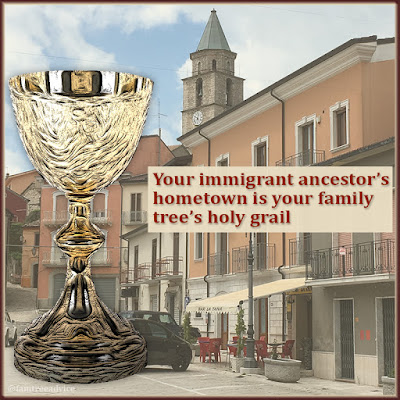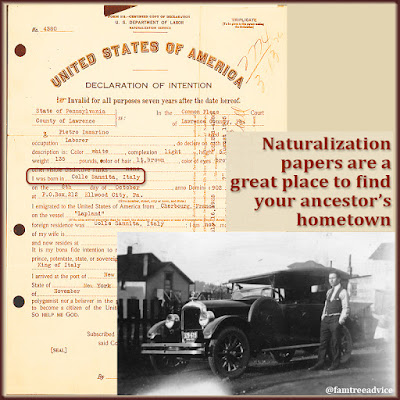The quest for the holy grail: your ancestor's place of birth.
You can't go back beyond your immigrant ancestor until you know where they were born. That town of birth is critical to finding documents.
I'm working on a couple who married in New York City in 1889. He was Giovanni Calleo. His naturalization papers have his exact birth date, but not his hometown. She was Cristina, and New York marriage indexes gave me her maiden name: Mastroianno. But nothing more.
I can't find Giovanni's immigration record. But he arrived in 1881. There's almost no chance his ship manifest will state his hometown. Her 1889 ship manifest has no details beyond her name and age. She arrived two weeks before her marriage. Two weeks! That makes me think they came from the same hometown. Family may have arranged the marriage and shipped her to the U.S.
 |
| Their hometown is everything. Your quest is to find your ancestor's hometown. |
To go any further back, I need to know where they came from. Here are 6 different avenues to explore.
1. Ship Manifests
My first traveling ancestor was my 2nd great grandfather. He made a few trips in the 1890s.
In 1898 he went back to Italy to bring over his wife and 2 of his children. That 1898 ship manifest has the details I needed.
My great aunt said the family came from Pastene. The 1898 ship manifest lists their town as "S. Angelo." I scoured a map for a while until I figured it out. Pastene is a frazione (a hamlet) of Sant'Angelo a Cupolo. With that information, I was able to learn so much.
A well-timed ship manifest is a great way to find your ancestor's hometown.
2. Naturalization Papers
United States naturalization papers have 3 varieties. A person first filed their Declaration of Intention to become a citizen. This form may include your ancestor's:
- place and date of birth
- the exact date of their arrival
- the name of the ship.
Next came the Petition for Naturalization. This may also include your ancestor's place and date of birth.
 |
| A thorough naturalization form can give you a ton of places, dates, names, and facts you need. |
Finally there is the actual naturalization. I have this document for Giovanni Calleo, but it confirms only his birth date.
I can't find Giovanni Calleo's declaration and petition. It may take a page-by-page search in the New York City court closest to where he lived.
3. Death Certificate
A close relative provides the facts on a death certificate. But what if they don't know the full names, proper spelling, and places of birth for their ancestors?
If you find a death certificate, keep in mind they may have Anglicized the names. What do you think the names might be in the original language? They may misspell the town of birth, if they include it.
4. Marriage Certificate
It's a bit of a rarity, but a marriage certificate may tell you where your immigrant ancestor was born. My ancestors' New York marriage certificates don't have a town; only a country. My grandparents' Ohio marriage license says she was born in Hornell, New York. But for Grandpa, it says only Italy.
A marriage certificate may be a long shot for finding an international place of birth. But it's a worthwhile search.
5. Find Others with the Name
Sometimes I'll search Ancestry for a last name only to see which towns the name generally comes from.
Searching for the name Mastroianno gives me a list of towns I can check. They include: Caiazzo, Caserta, Villa Santo Croce, Alvignano, Conflenti, Sezze, Benevento.
That's a lot to go on. Almost too much. Since Caiazzo came up a few times, I'll try there first.
I'll search the 1865 and 1869 birth records in these towns for Giovanni and Cristina.
6. Trace their Siblings
It's disappointing not to have found their hometowns yet. I have one ace left up my sleeve, and his name is Pasquale.
In the 1905 New York State census, Cristina's brother Pasquale Mastroianno is living with her. He's a 44-year-old married man who's been in the U.S. for 6 years. Did he plan to return to his wife and kids in Italy once he had enough money? Or was he going to bring them to America?
Pasquale's 1899 arrival should include his hometown. That'll be Cristina's hometown.
Here's what I found:
- An 1861 Italian birth record from the town of Falerna. The baby's parents are much too old to have had Cristina 8 years later. I looked anyway, and there is no record for her in that town.
- A 1900 ship manifest, hometown: Recale. While this is a good fit for Pasquale, I did not find Cristina born in Recale.
- An 1893 ship manifest, hometown: Nocera. There are 4 towns whose name begins with Nocera. I'll have to search all 4.
- An 1891 ship manifest, hometown: Palermo. He's heading to New York. It could be him.
- An 1890 ship manifest, hometown: Nicastro. My list of possible hometowns is getting awfully long.
- A 1902 ship manifest, hometown: Campochiaro. The 1905 census says he'd been in the U.S. for 6 years. This doesn't seem like a good fit.
- A 1905 ship manifest that's the Pasquale from the 1861 Italian birth record. He was going to Pittsburgh.
Lots more ship manifests, city directories, and naturalization indexes didn't fit this Pasquale.
Usually one of the first 3 methods would give me what I need. But this family is a tough one. Since I know Giovanni's birth date and Cristina's birth year, my best hope is that long list of towns.
I'll search for them in the birth records for each town in the list.
That hometown is the holy grail. If I find their birth records, I'll have their parents' names. I can search for their parents' marriages, and so on.
Don't give up on your search. Try every path until one leads you where you want to go.
And now for some déjà vu:











